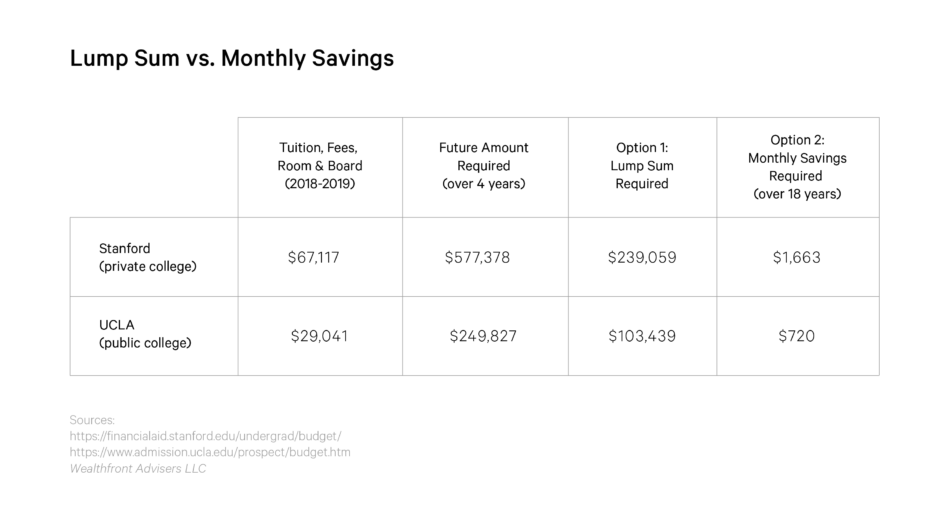Many experts consider the 529 plan to be one of the best ways to save for college due to its tax benefits and relative flexibility. Here's more on why.
Soft skin. Warm snuggles. First smiles. A new baby brings so much joy into your life.
And with that joy comes focus — on trying to do everything right, on trying to give everything to your child.
One of the things you should be thinking about? Paying for college. By the time today’s newborns leave the nest, the average cost of a four-year private education could be $302,700, according to Wealthfront research.
Although that number is undoubtedly daunting — and that future seems unfathomably far away — starting early will give your money time to grow. That’s where a 529 plan comes in. Here are four steps to take right now.
Calculate how much you hope to save
Though most parents save for college by diligently socking away money each month, we’d encourage you to start with a lump sum. Why? Because it’ll give your investment the most time to compound:
- To pay for your child to attend Stanford, you could either save $1,663 per month, over 18 years, for a total of $359,208. Or you could deposit $239,059 today — and let it grow.
- To pay for your child to attend UCLA, you could either save $720 over 18 years, for a total of $155,520. Or you could deposit $103,439 today — and let it grow over the next 18 years.
Here’s a chart that shows the difference:

Note: The future amount required is calculated by taking this year’s tuition, fees, room & board and applying 4% annual inflation (higher education inflation on average is approximately 2% higher than the average increase in the Consumer Price Index). The lump sum required now is the amount needed to invest this year assuming 4.7% investment returns, which is the average net-of-fee annual expected return for Wealthfront 529 risk score 9.0 investment plan, to meet the future amount required at matriculation. This compares to the monthly savings required if you can’t invest via lump sum and instead contribute the same amount every month to meet the goal.
Of course, six figures of cash is tough to come by, and won’t be a feasible option for many parents. But the point isn’t how much you put in; the point is it’s incredibly valuable to start with whatever lump sum you can afford.
To make your own calculations, log into Wealthfront and use our automated financial planning to estimate the future costs of a particular college, predict financial aid, and create realistic savings goals.
Open up a 529 account
Because of their tax benefits and relative flexibility, many experts consider 529 plans one of the best ways to save for college.
Here’s why:
You’ll receive tax advantages
Your money grows tax-free. Withdrawals are also tax-free, as long as they’re used toward tuition, fees, books, room and board, computers, etc.
You’ll remain the boss
As a parent, you can maintain ownership of the 529 plan, and make your child the beneficiary. This has two benefits: You’ll have complete control over when and how the money is withdrawn, and when it comes to applying for financial aid, your child won’t have a huge account in their name. (Keep in mind: You can always change the beneficiary in the future if you have more than one kid.)
You can superfund the 529
You can make a large, tax-advantaged lump sum investment, which is known as “superfunding.” You and your spouse can each invest five times the annual gift tax limit of $15,000 (for a total of $150,000 per child, per couple) — which would allow ample time for compounding, and give you a significant head start on your college savings goals.
You can use it for K-12, too
Under the new tax law, you can now withdraw up to $10,000 per year, tax- and penalty-free, to use for private school tuition. Not all states have gotten on board yet, so check your specific 529 plan before going this route.
The biggest downside of 529s? They’re not flexible. If your child decides to skip college, or gets a full-ride scholarship, you could transfer the account to a sibling or cousin. But if you end up using the money for non-education expenses, you’ll owe taxes on the earnings, plus a 10% penalty.
There are other options to consider outside of 529 accounts — you can also save for college with a Coverdell Education Savings Account or Custodial Account. Below, we cover the basics of each:
Coverdell Education Savings Accounts (ESAs)
- Can be used for qualified education expenses
- Money accumulates tax-free
- Have extremely low contribution limits ($2,000 per year)
- Phase out your ability to contribute after your income hits $95,000 per year (or $190,000 for married couples)
- If money isn’t used for educational expenses, earnings are subject to tax and a penalty
Custodial Accounts (Uniform Gifts to Minors Act / Uniform Transfers to Minors Act)
- Can use accounts for any purpose — not just education expenses
- Money does not accumulate tax-free
- Child gains complete control after they become an adult (usually at age 18)
- Are considered your child’s asset, which can lower their financial aid award
Choose the best 529 plan for you
If you couldn’t tell already, we think 529 plans are an ideal way to save for college. When it comes to picking a particular 529 plan, you have a lot of options. Each state, plus the District of Columbia, administers its own plans, and you can choose whichever one appeals to you.
While your home state should be a consideration, you don’t have to choose the state you live in, or the state in which you think your child will attend college. If you live in California, for example, you could enroll in Nevada’s plan, and then eventually use the money to send your child to school in New York. For helpful breakdowns of each state’s 529 plan, visit Saving for College.
The only exception is if you choose a “prepaid tuition plan,” which lets you lock in today’s tuition at public schools in your state. Since these aren’t very flexible, however, we generally don’t suggest using them. By choosing a regular 529 plan, your child can use the money for Qualified Higher Education Expenses at any eligible institution — no matter which state sponsored the plan.
In addition to reading reviews and analyzing investment options, you should also consider these factors when selecting your plan:
State income tax deductions
More than 30 states offer residents state income tax deductions for contributing to their specific 529 plans. Seven states offer a deduction for contributing to any plan — even if it’s administered by a different state. For a full list of state tax policies, read the Wealthfront 529 White Paper.
Fees
Management and administrative fees vary greatly depending on the plan. Advisor-sold plans, which usually come with personalized financial advice and active management, are pricier than direct-sold plans, which tend to feature low-cost funds.
Pick investments for your 529
You’re almost there! Once you’ve decided which 529 plan to use, you’ll also need to decide how to invest the money within it.
While a broker or advisor may try to steer you into actively managed mutual funds, we wouldn’t suggest using them. Advisors may make gleaming promises of “beating the market,” but research shows that, when fees are taken into account, actively managed funds actually fare worse than index funds.
So, as always, we advise looking for index funds and other low-cost, passively managed investments.
Within many 529s, you’ll find age-based options that, like target-date retirement funds, automatically adjust their asset allocation as your child gets closer to college. Though this trajectory, known as a glide path, would ideally take your risk tolerance into account, many direct-sold plans don’t personalize their recommendations.
Many direct-sold plans also only offer between one and five different asset classes — and according to our research, that’s no good. Additional asset classes can help your returns in the long run.
No matter which strategy and which 529 you choose, we hope you’ll start saving today. We’d say your child’s future is worth it — wouldn’t you?
*Source: Wealthfront Research with data from from IPEDS, as of March 2018.
This post is part of a series on Saving for College— read more about superfunding your 529 and the 4 big things you should contemplate now if you have kids who may be college-bound in the future.
Disclosure
The Wealthfront 529 College Savings Plan (Plan) is administered by the Board of Trustees of the College Savings Plans of Nevada (Board). Ascensus Broker Dealer Services, Inc. serves as Program Manager, and Wealthfront Advisers LLC (“Wealthfront Advisers,” and the successor investment adviser to Wealthfront Inc.), an SEC-registered investment adviser, serves as the investment adviser to the Plan.
Anyone may invest in the Plan and use the proceeds to pay for qualified higher education expenses of a beneficiary at an eligible educational institution. If you withdraw money for something other than qualified higher education expenses, you will owe federal income tax and may face a 10% penalty on your earnings.
Before investing in a 529 plan, consider whether your state’s plan or that of your beneficiary offers state tax and other benefits not available through the Plan.
All investing involves risk, including the possible loss of money you invest. Past performance does not guarantee future performance. Consider the investment objectives, risks, charges, and expenses of any 529 plan before investing. Please review the Plan Description and Participation Agreement carefully before investing. Request one by calling us at (844) 995-8437 or emailing support@wealthfront.com. Your investment is not insured or guaranteed by the State of Nevada, the Board, Plan or any state official, the FDIC or any other federal agency, the Program Manager or Wealthfront Advisers.
Wealthfront Brokerage LLC, member FINRA / SIPC, serves as distributor and underwriter of the Plan. Neither Wealthfront Brokerage LLC or Wealthfront Advisers provide tax advice, and investors are encouraged to consult with their personal tax advisor. Both Wealthfront Advisers and Wealthfront Brokerage LLC are wholly owned subsidiaries of Wealthfront Corporation.

About the author(s)
The Wealthfront Team believes everyone deserves access to sophisticated financial advice. The team includes Certified Financial Planners (CFPs), Chartered Financial Analysts (CFAs), a Certified Public Accountant (CPA), and individuals with Series 7 and Series 66 registrations from FINRA. Collectively, the Wealthfront Team has decades of experience helping people build secure and rewarding financial lives. View all posts by The Wealthfront Team


